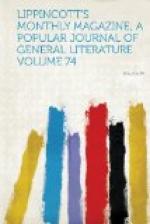The purpose and intention of the journey was now abundantly fulfilled. Had the travelers rested satisfied with the liberal indications they had found, and consented to place themselves between the haunts of the savages and the abodes of civilization, with a tendency and determination toward the latter, they might have returned with safety as with glory. The estimate made by Eusebio, however, of the trend or direction of the calisaya groves, induced him to forsake the bed of the Cconi, and strike south-eastwardly, so as to cross the Ollachea and the Ayapata.
“But the mountains are disappearing,” hazarded Mr. Marcoy. “Will not the cinchonas disappear with them?”
“Oh,” answered the majordomo, like a pedagogue to a confident school-boy, “the senor knows better how to put ink or color on a sheet of paper than how to judge of these things. The plain, the campo llano, is far enough to the east. Before we should see the disappearance of the mountains, we should have to cross as many hills and ravines as we have left behind us.”
“What do you think of doing, then?” naturally demanded Marcoy, who had long since begun to feel that the expedition had but one chief, and that was the sepia-colored cascarillero from Bolivia,
“Everything and nothing,” answered Eusebio.
These enigmas always carry the day. The apparatus of march was once more set in motion toward the adjacent water-sheds. After a considerable journey—rewarded, it must be said, with a succession of cinchona discoveries—they halted near a clearing in the forest, where large heaps of stones and pebbles, arranged in semicircles, attracted their attention. The cascarilleros explained this appearance as due to former arrangements for gold-washing in an old river-bed, the San Gavan or the Ayapata, that had now changed its locality.
While examining the unusual appearance an abominable clamor burst from the woods around, and a band of Siriniris appeared, led by a lusty ruffian crowned with oriole feathers, whom the travelers recognized as having been among their previous acquaintances.
The encounter was very disagreeable, but the strangers determined to make the best of it. The manner of this band of Indians was somewhat different from that of the others. They brought nothing for barter, and had an indescribably coarse and hardy style of behavior.
The travelers determined to buy a little information, if nothing better, with their knives and fish-hooks. Garcia was accordingly instructed to demand the meaning of the heaps and causeways of stones. The savages laughed at first, but finally informed the visitors that the constructions which puzzled them so had been made by people of their own race many years ago, for the purpose of gathering gold from the river which used to run along there, but which now flowed seven miles off.




